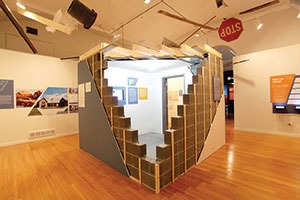Masonry Trends
Designing for Disaster
A new exhibit at the National Building Museum is changing the way we think about designing buildings to withstand the elements.

Designing for Disaster is an exhibit currently showing at the National Building Museum in Washington, D.C. The exhibition focuses on how safer, more disaster-resilient communities can be built. Exhibit attendees are educated through stories, video, objects, and interactive tools from around the nation. The museum was guided by two principles: where we should we build, and how we should build.
Masonry??sat down with museum curator Chrysanthe Broikos to discuss the ideas behind the exhibit and what they might have learned. Following is what she had to say.
Masonry: Why is the National Building Museum focusing on designing for disaster?
Chrysanthe Broikos: Natural disasters directly affect the health and well-being of our citizens, our economy, and the built environment; the stakes couldn’t be much higher. As climate changes, infrastructure ages, and more of us settle in desirable, but highly vulnerable areas, the costs are likely to rise.
Masonry: Do you feel masonry is a preferred building material when designing for disaster?
Broikos: It certainly can be. In our gallery devoted to hurricanes and tornadoes, we give center stage to a FEMA-specified safe room constructed with CMU walls.??In the water hazard gallery, we highlight an ICF-built (insulating concrete forms) home that survived Hurricane Katrina and another concrete home that survived Hurricane Sandy. Masonry is featured prominently in many of the case studies: It’s a critical piece of a larger picture.
 |
|
| ?? | Designing for Disaster at the National Building Museum. Photo by Allan Sprecher, courtesy of the National Building Museum |
Masonry: How much do building codes and standards help or hinder designing for disaster?
Broikos: I definitely consider codes to be an important tool for strengthening and improving how we build. Unfortunately, I don’t think many retail consumers understand that the code is a minimum standard. As I was doing research, many professionals in the building industry also pointed out how important code enforcement is. People make the code work.
Masonry: What are your thoughts on building inexpensively versus building to last, and how does this play into designing for disaster?
Broikos: First, I think smart design and engineering have a major role to play in building to better deal with natural disasters – we can do it.??I certainly can’t argue with building to last or wisely using resources. I do think we need to be thinking more about life-cycle costs, not just initial outlays. But I have also come to better understand that not all structures need to meet the same requirements.
Masonry: What are the most effective and affordable mitigation strategies?
Broikos: To be honest, I think we overlook the importance of regular building maintenance and smart landscaping.??When it comes to fire, for example, landscaping can really make a difference.??The good news is there are lots of options and products out there that can improve a home’s resiliency, especially when it comes time to replace your roof, garage door, or windows.
Masonry: Which are the most at-risk areas of the country for disasters?
Broikos: One of the exhibition’s goals is to help people understand that no area of the country is immune to natural hazards, and that natural disasters can strike anywhere, at any time.??One benefit of being prepared for natural disasters is that you will likely be prepared for other types of emergencies or disasters, which makes us all more resilient.
Designing for Disaster will be on display at the National Building Museum in Washington, D.C., through Aug. 2, 2015. For more information, visit www.nbm.org/exhibitions-collections/exhibitions/designing-for-disaster.html.